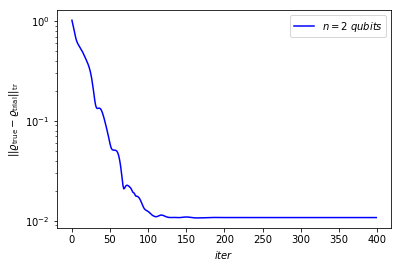Quantum state tomography¶
One can open this notebook in Google Colab (is recommended)
In this tutorial, we perform quantum state tomography via Riemannian optimization. First two blocks of a code (1. Many-qubit, informationally complete, positive operator-valued measure (IC POVM) and 2. Data set generation (measurement outcomes simulation)) are refered to data generation, third bock dedicated to tomography of a state.
First, one needs to import all necessary libraries.
[1]:
import tensorflow as tf # tf 2.x
from math import sqrt
try:
import QGOpt as qgo
except ImportError:
!pip install git+https://github.com/LuchnikovI/QGOpt
import QGOpt as qgo
import matplotlib.pyplot as plt
from tqdm import tqdm
# Fix random seed to make results reproducable.
tf.random.set_seed(42)
1. Many-qubit, informationally complete, positive operator-valued measure (IC POVM)¶
Before generating measurement outcomes and performing quantum tomography, one needs to introduce POVM describing quantum measurements. For simplicity, we use one-qubit tetrahedral POVM and generalize it on a many-qubit case by taking tensor product between POVM elements, i.e. \(\{M_\alpha\}_{\alpha=1}^4\) is the one-qubit tetrahedral POVM, \(\{M_{\alpha_1}\otimes \dots \otimes M_{\alpha_N}\}_{\alpha_1=1,\dots,\alpha_N=1}^4\) is the many-qubits tetrahedral POVM.
[2]:
# Auxiliary function that returns Kronecker product between two
# POVM elements A and B
def kron(A, B):
"""Kronecker product of two POVM elements.
Args:
A: complex valued tensor of shape (q, n, k).
B: complex valued tensor of shape (p, m, l).
Returns:
complex valued tensor of shape (q * p, n * m, k * l)"""
AB = tf.tensordot(A, B, axes=0)
AB = tf.transpose(AB, (0, 3, 1, 4, 2, 5))
shape = AB.shape
AB = tf.reshape(AB, (shape[0] * shape[1],
shape[2] * shape[3],
shape[4] * shape[5]))
return AB
# Pauli matrices
sigma_x = tf.constant([[0, 1], [1, 0]], dtype=tf.complex128)
sigma_y = tf.constant([[0 + 0j, -1j], [1j, 0 + 0j]], dtype=tf.complex128)
sigma_z = tf.constant([[1, 0], [0, -1]], dtype=tf.complex128)
# All Pauli matrices in one tensor of shape (3, 2, 2)
sigma = tf.concat([sigma_x[tf.newaxis],
sigma_y[tf.newaxis],
sigma_z[tf.newaxis]], axis=0)
# Coordinates of thetrahedron peaks (is needed to build tetrahedral POVM)
s0 = tf.constant([0, 0, 1], dtype=tf.complex128)
s1 = tf.constant([2 * sqrt(2) / 3, 0, -1/3], dtype=tf.complex128)
s2 = tf.constant([-sqrt(2) / 3, sqrt(2 / 3), -1 / 3], dtype=tf.complex128)
s3 = tf.constant([-sqrt(2) / 3, -sqrt(2 / 3), -1 / 3], dtype=tf.complex128)
# Coordinates of thetrahedron peaks in one tensor of shape (4, 3)
s = tf.concat([s0[tf.newaxis],
s1[tf.newaxis],
s2[tf.newaxis],
s3[tf.newaxis]], axis=0)
# One qubit thetrahedral POVM
M = 0.25 * (tf.eye(2, dtype=tf.complex128) + tf.tensordot(s, sigma, axes=1))
n = 2 # number of qubits we experiment with
# M for n qubits (Mmq)
Mmq = M
for _ in range(n - 1):
Mmq = kron(Mmq, M)
2. Data set generation (measurement outcomes simulation).¶
Here we generate a set of measurement outcomes (training set). First of all, we generate a random density matrix that is a target state we want to reconstruct. Then, we simulate measurement outcomes over the target state driven by many-qubits tetrahedral POVM introduced in the previous cell.
[3]:
#-----------------------------------------------------#
num_of_meas = 600000 # number of measurement outcomes
#-----------------------------------------------------#
# random target density matrix (to be reconstructed)
m = qgo.manifolds.DensityMatrix()
A = m.random((2 ** n, 2 ** n), dtype=tf.complex128)
rho_true = A @ tf.linalg.adjoint(A)
# measurements simulation (by using Gumbel trick for sampling from a
# discrete distribution)
P = tf.cast(tf.tensordot(Mmq, rho_true, [[1, 2], [1, 0]]), dtype=tf.float64)
eps = tf.random.uniform((num_of_meas, 2 ** (2 * n)), dtype=tf.float64)
eps = -tf.math.log(-tf.math.log(eps))
ind_set = tf.math.argmax(eps + tf.math.log(P), axis=-1)
# POVM elements came true (data set)
data_set = tf.gather_nd(Mmq, ind_set[:, tf.newaxis])
3. Data processing (tomography)¶
First, we define an example of the density matrices manifold:
[4]:
m = qgo.manifolds.DensityMatrix()
The manifold of density matrices is represneted through the quadratic parametrization \(\varrho = AA^\dagger\) with an equivalence relation \(A\sim AQ\), where \(Q\) is an arbitrary unitary matrix. Thus, we initialize a variable, that represents the parametrization of a density matrix:
[5]:
# random initial paramterization
a = m.random((2 ** n, 2 ** n), dtype=tf.complex128)
# in order to make an optimizer works properly
# one need to turn a to real representation
a = qgo.manifolds.complex_to_real(a)
# variable
a = tf.Variable(a)
Then we initialize Riemannian Adam optimizer:
[6]:
lr = 0.07 # optimization step size
opt = qgo.optimizers.RAdam(m, lr)
Finally, we ran part of code that calculate forward pass, gradients, and optimization step several times until convergence is reached:
[7]:
# the list will be filled by value of trace distance per iteration
trace_distance = []
for _ in range(400):
with tf.GradientTape() as tape:
# complex representation of parametrization
# shape=(2**n, 2**n)
ac = qgo.manifolds.real_to_complex(a)
# density matrix
rho_trial = ac @ tf.linalg.adjoint(ac)
# probabilities of measurement outcomes
p = tf.tensordot(rho_trial, data_set, [[0, 1], [2, 1]])
p = tf.math.real(p)
# negative log likelihood (to be minimized)
L = -tf.reduce_mean(tf.math.log(p))
# filling trace_distance list (for further plotting)
trace_distance.append(tf.reduce_sum(tf.math.abs(tf.linalg.eigvalsh(rho_trial - rho_true))))
# gradient
grad = tape.gradient(L, a)
# optimization step
opt.apply_gradients(zip([grad], [a]))
Here we plot trace distance vs number of iteration to validate the result
[8]:
plt.plot(trace_distance, 'b')
plt.legend([r'$n=$' + str(n) + r'$\ qubits$'])
plt.yscale('log')
plt.ylabel(r'$||\varrho_{\rm true} - \varrho_{\rm trial}||_{\rm tr}$')
plt.xlabel(r'$iter$')
[8]:
Text(0.5,0,'$iter$')
